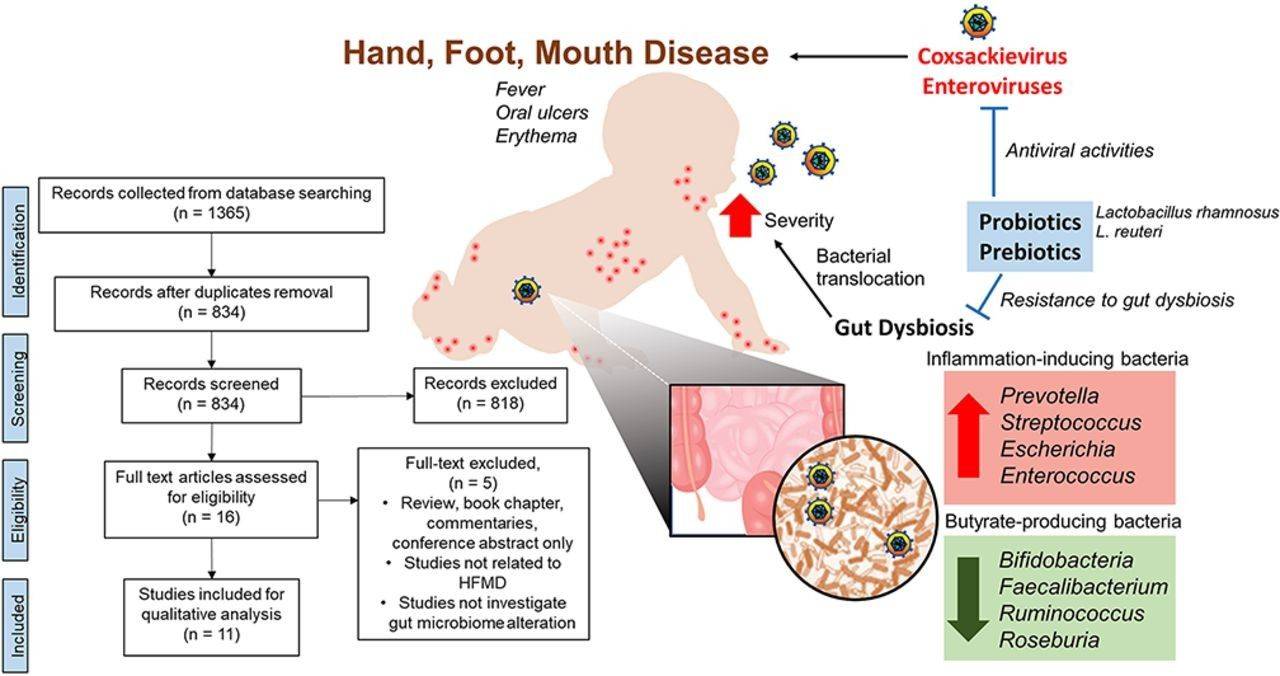Hand, foot, and mouth disease (HFMD) remains a significant global health concern, particularly in pediatric populations, with outbreaks frequently caused by enteroviruses including Coxsackievirus A16 and the more severe Enterovirus 71 (EV-A71). This resource provides a detailed overview of modern diagnostic approaches, from clinical suspicion to pathogen identification, equipping healthcare professionals with essential knowledge to optimize testing protocols and improve patient outcomes.
Overview of Hand, Foot, and Mouth Disease (HFMD)
Hand, foot, and mouth disease (HFMD) is a highly contagious viral illness primarily affecting young children, characterized by fever, oral ulcers, and a distinctive vesicular rash on the hands, feet, and buttocks. Most commonly caused by Coxsackievirus A16 (typically mild) and Enterovirus 71 (EV-A71) (associated with severe neurological complications), HFMD spreads rapidly in childcare settings and can lead to regional outbreaks.
 Fig.1 Pathogenesis of hand, foot, and mouth disease (HFMD). (Tan L T H, et al., 2022)
Fig.1 Pathogenesis of hand, foot, and mouth disease (HFMD). (Tan L T H, et al., 2022)
Clinical Suspicion for Hand, Foot, and Mouth Disease (HFMD)
Hand, foot, and mouth disease (HFMD) should be suspected in children presenting with the classic triad of fever, painful oral ulcers, and vesicular rash on hands, feet, and/or buttocks, particularly during community outbreaks or in daycare settings. While most cases are mild and self-limiting, neurological red flags (e.g., persistent vomiting, myoclonus, or lethargy) should raise concern for neurovirulent EV-A71 infection and prompt urgent testing. Differential diagnoses include herpangina, chickenpox, and herpes gingivostomatitis. Early clinical recognition is critical to guide appropriate laboratory confirmation and monitor for rare but severe complications like encephalitis or cardiopulmonary failure.
Diagnostic Methods for Hand, Foot, and Mouth Disease (HFMD)
Accurate diagnosis of hand, foot and mouth disease is essential for clinical management and outbreak control, especially helping to differentiate benign cases from neurovirulent EV-A71 infection. Three major laboratory methods, including molecular testing (RT-PCR), serological testing (IgM/IgG), and rapid antigen testing, each have their own advantages depending on disease stage, resource availability, and clinical urgency.
Molecular Detection (RT-PCR)
RT-PCR is the gold standard for acute-phase diagnosis, detecting viral RNA with >95% sensitivity within 1–5 days of symptom onset. It targets conserved regions (e.g., VP1 gene for strain-specific identification of EV-A71/CV-A16, or *5'-UTR* for pan-enterovirus screening). Multiplex assays enable simultaneous detection of multiple pathogens (e.g., EV-A71, CV-A16, other enteroviruses), making it ideal for outbreak settings.
Serological Testing (IgM/IgG)
Serology is valuable for retrospective diagnosis (after day 5) or epidemiological studies, detecting IgM antibodies (appearing 2–5 days post-infection) and IgG (indicating past exposure). However, cross-reactivity among enteroviruses reduces specificity, and paired acute/convalescent samples (2–4 weeks apart) are often needed to confirm recent infection.
Rapid Antigen Tests
Lateral flow rapid tests detect VP1 protein in throat swabs or vesicular fluid, providing results in 15–30 minutes without lab infrastructure. While advantageous for point-of-care screening, their moderate sensitivity (60–80%) and inability to differentiate strains (e.g., EV-A71 vs. CV-A16) restrict clinical utility. Emerging improvements, such as nanoparticle-based assays, aim to address these gaps for field use.
Biomarkers for Hand, Foot, and Mouth Disease (HFMD)
Biomarkers play an increasingly critical role in hand, foot and mouth disease (HFMD) management, offering tools for accurate diagnosis, severity prediction, and therapeutic monitoring. As HFMD ranges from mild, self-limiting cases to severe neurological complications (particularly with EV-A71), biomarkers help bridge gaps in clinical assessment and laboratory testing. Below, we categorize key biomarkers into diagnostic, prognostic, and emerging classes, highlighting their applications and limitations.
Diagnostic Biomarkers
HFMD diagnostic biomarkers focus on direct pathogen detection, primarily through VP1/5'-UTR viral RNA and VP1 protein. While RT-PCR offers strain-specific identification, antigen tests provide rapid but less sensitive (~60-80%) screening.
Prognostic Biomarkers
These biomarkers predict disease severity, with elevated IL-6, IFN-γ, and viral load strongly correlating with neurological complications. Such markers enable early intensive care referrals and may guide immunomodulatory therapy decisions.
Emerging Biomarkers
Innovative approaches include miRNA signatures (e.g., miR-146a) and metabolic markers (CSF lactate), currently in research phases. Next-gen platforms aim to combine pathogen detection with host-response profiling, potentially enabling precision POC testing.
Future of Hand, Foot, and Mouth Disease (HFMD) Diagnostics
The future of hand, foot and mouth disease (HFMD) diagnostics is advancing toward integrated, intelligent systems that combine ultrasensitive molecular detection with real-time prognostic insights to transform clinical management. Next-generation technologies like POC assays and AI-powered risk stratification tools will enable simultaneous pathogen identification (EV-A71 vs. CV-A16) and severity prediction (via host biomarkers like IL-6/miRNAs), while cloud-connected platforms could revolutionize outbreak surveillance.
Alta DiagnoTech delivers a comprehensive portfolio of IVD products for hand, foot and mouth disease (HFMD), spanning high-precision RT-PCR assays, rapid antigen tests, and innovative biomarker detection tools. If you have related needs, please feel free to contact us for more information or product support.
Reference
- Tan L T H, Letchumanan V, Law J W F, et al. IDDF2022-ABS-0221 The roles of GUT microbiota in hand, foot and mouth disease[J]. Gut, 2022, 71(Suppl 2): A61-A61.
This article is for research use only. Do not use in any diagnostic or therapeutic application.



 Fig.1 Pathogenesis of hand, foot, and mouth disease (HFMD). (Tan L T H, et al., 2022)
Fig.1 Pathogenesis of hand, foot, and mouth disease (HFMD). (Tan L T H, et al., 2022)




